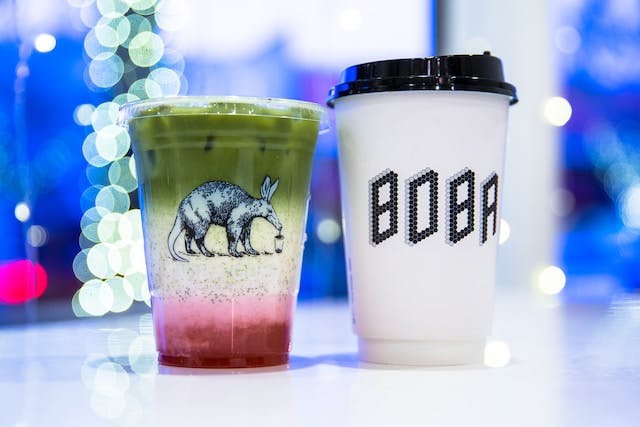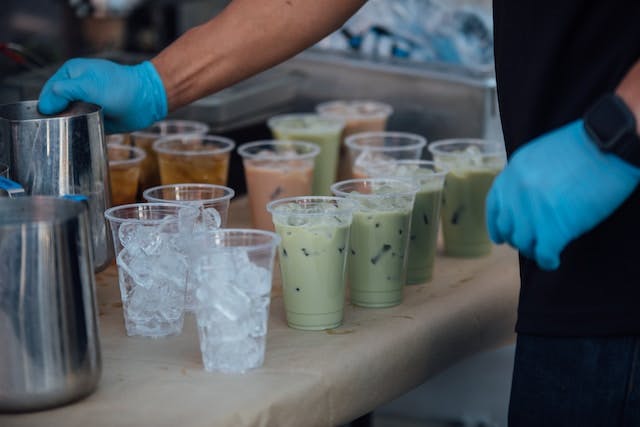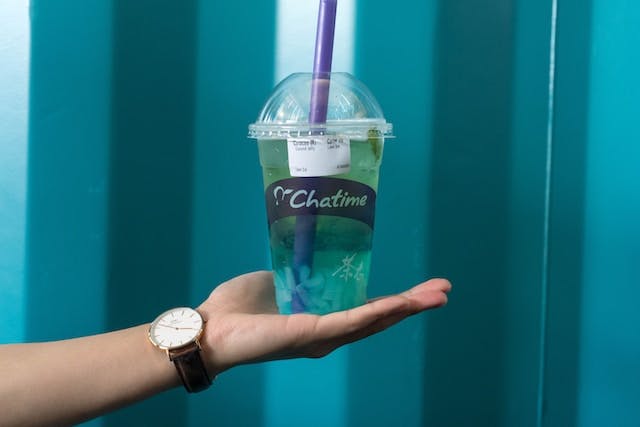What is Bubble Tea? A Deep Dive into the Popular Beverage
Bubble tea first appeared in the little tea shops of Taiwan in the 1980s and quickly spread over the globe. This distinctive drink, commonly referred to as boba tea, has advanced from its modest origins to become a widely recognized beverage. Due to its rising popularity, more and more bubble tea businesses are opening up in major cities worldwide. The cultural relevance of bubble tea is clear given that it has come to represent modern Asian culture and how it has influenced international culinary trends.
What is Bubble Tea?
Fundamentally, bubble tea is a tea-based beverage made with four primary components: tea, milk, sugar, and tapioca pearls. However, the versatility and unlimited variety of bubble tea are what makes it so beautiful.
Anything from black and green to white or oolong tea can be used. In some stores, you can choose between fruit teas and herbal teas. For a fruit-infused tea, the milk can be completely removed, substituted with non-dairy milk, or used as usual. It is frequently possible to alter the sugar amount, satisfying both individuals with a sweet tooth and others who want a less sweet beverage.
 Owner: Jason LeungGreen and white tumblers
Owner: Jason LeungGreen and white tumblersThe star of the show is the little balls known as tapioca pearls, which are made of tapioca starch and have a chewy, gummy bear-like quality. Due to the "bubbly" look they produce when they rise and fall in the glass, these pearls are what gave bubble tea its name. However, a lot of stores now sell a range of additional "toppings" or "sinkers," such as jelly cubes, pudding, or fruit slices.
These components work together to create a delicious beverage that is also enjoyable to consume. Drinking bubble tea is a lot of fun because of the experience of drinking tea through a big straw and occasionally getting a mouthful of chewy tapioca pearls.
For a more in-depth look at the origins and variations of bubble tea, check out Kung Fu Tea's explanation of bubble tea and Wikipedia's entry on bubble tea.
The Origin of Bubble Tea
Early in the 1980s, in Taiwan, bubble tea first became popular. Around this period, tea shops began a custom that soon caught on: flavoring their iced tea with fruit. But the inclusion of tapioca pearls changed everything. Liu Han-Chieh, who began serving cold tea with these chewy additives in his Taichung, Taiwan tea business, Chun Shui Tang, is frequently credited with this invention.
Refreshing tea, sweet and creamy milk, and chewy tapioca pearls made for an intriguing mix that soon gained popularity. Taiwan saw a boom in the number of tea shops providing bubble tea, as the drink became increasingly popular there.
The introduction of bubble tea to nearby nations in East and Southeast Asia in the 1990s marked the beginning of its global emergence. Bubble tea was introduced to new populations as Taiwanese immigrants opened shops and emigrated to other regions of the world. As evidence of the Taiwanese invention's widespread appeal, bubble tea businesses can now be found in major cities all over the world, from New York to Sydney, London to Johannesburg.
 Owner: Frank ZhangDisposable cups with shakes
Owner: Frank ZhangDisposable cups with shakesHow is Bubble Tea Made?
There are only a few essential processes in the preparation of bubble tea, though the steps may differ slightly based on the flavor and type of tea used. Here is a simple procedure in steps:
Brew the tea: The tea must first be brewed. This could be oolong, black, green, or white tea. Typically, tea is steeped for a few minutes before being allowed to cool.
Prepare the tapioca pearls: To make the tapioca pearls chewy and pliable, they are boiled. After being cleaned, they are combined with sugar syrup to give them a sweet flavor.
Mix the drink: The brewed tea is combined with the milk, sweetener (often sugar syrup), and milk. To create a frothy, well-mixed cocktail, perform this in a shaker or blender.
Assemble the drink: The tea mixture is then put to the glass with the sweetened tapioca pearls. Usually, a wide straw large enough to suck up the tapioca pearls is included with the beverage.
Different varieties of tea, fruit flavors or juice, different types of milk (such almond milk or condensed milk), and other toppings like jelly or pudding can all be used as variations on the recipe. Some stores also let you alter the amount of sugar and ice in your beverage, creating a more individualized bubble tea experience.
For more details on the process of making bubble tea, you can check out The Spruce Eats' article on white tea.
The Different Types of Bubble Tea
Its adaptability is what makes bubble tea so lovely. The options are infinite with so many different teas and toppings available. Some of the most typical varieties are listed below:
Tea Types: The flavor of the bubble tea can be significantly altered by the type of tea used. Although white tea, oolong tea, and green tea are also popular options, black tea is the most widely consumed. For those seeking caffeine-free options, some stores even sell fruit teas, which are teas flavored with fruit.
Toppings: While tapioca pearls are the standard topping in bubble tea, many other options have emerged. Jelly toppings, made from coconut or fruit, add a different texture and flavor. Pudding toppings, similar to flan or custard, offer a creamy, rich addition. There are also popping boba, which are filled with fruit juice and burst in your mouth.
 Owner: Moujib AghroutChatime beverage with lid and straw
Owner: Moujib AghroutChatime beverage with lid and strawNutritional Information
The nutritional value of bubble tea can vary substantially depending on the components used, just like it might with any other food or beverage. Typically, 16 ounces of bubble tea have 200–450 calories in them. The tea itself has almost no calories, whereas the tapioca pearls alone have roughly 100 calories per serving. The remaining calories come from the milk and sugar that were added.
Although bubble tea can contain a lot of sugar, many places let you choose how sweet it is, so you can cut back on the sugar. Additionally, some stores sell healthy substitutes like almond milk, skim milk, and sugar-free syrups.
Although bubble tea can be a delectable treat, it should be eaten in moderation as part of a healthy diet, it is vital to emphasize. If consumed in excess, the high sugar level can contribute to health problems like obesity and diabetes.
Bubble Tea Culture
The popularity of bubble tea is not merely a culinary trend; it is also a cultural one. Bubble tea is more than simply a beverage in its native Taiwan; it is a source of pride and a symbol of the country's identity. From the development of bubble tea businesses on every street corner to its appearance in media and popular culture, the beverage has significantly influenced Taiwanese culture.
The bubble tea culture has also spread globally. From Asia to North America, Europe to Australia, bubble tea shops have become a common sight in cities around the world. These shops often become social gathering places, especially for young people. The global spread of bubble tea culture is a testament to the drink's universal appeal and adaptability.
Glossary of Unique and Specific Terms Related to Bubble Tea
Word | Definition |
|---|---|
Bubble Tea | A Taiwanese tea-based drink invented in Tainan and Taichung in the 1980s. |
Boba | Another name for bubble tea, also refers to the tapioca pearls commonly found in the drink. |
Tapioca Pearls | Spherical balls made from tapioca starch, giving them a chewy, gummy-bear like consistency. |
Black Tea | A type of tea that is more oxidized than green, oolong, and white teas. |
Green Tea | A type of tea that is made from Camellia sinensis leaves and buds that have not undergone the same withering and oxidation process used to make oolong teas and black teas. |
White Tea | The least processed form of tea, known for its delicate and subtle flavor. |
Oolong Tea | A traditional semi-oxidized Chinese tea produced through a process including withering the plant under strong sun and oxidation before curling and twisting. |
Herbal Tea | A type of beverage made by infusing the leaves, seeds, roots, or bark of plants other than the traditional tea plant. |
Fruit Tea | Tea that is flavored with fruit flavor. |
Jelly Toppings | Toppings made from coconut or fruit, add a different texture and flavor to bubble tea. |
Pudding Toppings | Toppings similar to flan or custard, offer a creamy, rich addition to bubble tea. |
Popping Boba | Toppings filled with fruit juice and burst in your mouth. |
Cassava Root | A root vegetable that is a major source of carbohydrates, tapioca pearls are made from the starch of this root. |
FAQs
What exactly is bubble tea?
Usually made with tea, milk, sugar, and tapioca pearls, bubble tea is a popular beverage in Taiwan. The beverage is renowned for its distinctive fusion of tastes and textures, and it can be personalized with various tea varieties, varied amounts of sweetness, and a range of toppings.
What is so special about bubble tea?
The variety of bubble tea and the drinking experience are what make it unique. The flavor and texture of this beverage are distinctive and unmatched by anything else due to the mixture of ice-cold tea, rich milk, sweet syrup, and chewy tapioca pearls. Every bubble tea can also be a special experience because there are so many ways to customize it.
What are bubble tea balls made of?
The tapioca starch from the cassava root is used to make the "balls" in bubble tea, also known as boba or tapioca pearls. After being boiled until soft and chewy, they are typically sweetened with sugar syrup.
Are bubble tea drinks healthy?
Depending on the components utilized, bubble tea's level of healthiness might vary significantly. Despite being low in calories and having health advantages, tea can become heavy in calories and sugar when sugar and toppings are added. It is feasible to make your bubble tea healthier because many bubble tea restaurants provide options to cut the sugar content or use healthier substitutes. However, like any sweet drink, it should be consumed in moderation.
Editor & Tea Lover